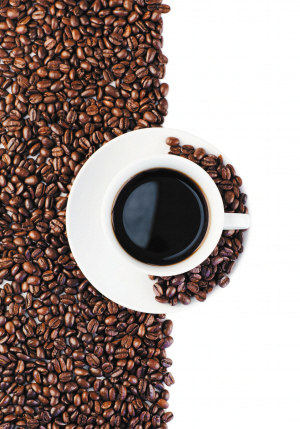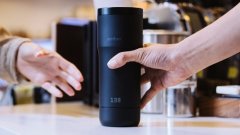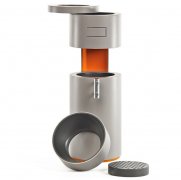How to get a cup of decaffeinated coffee?
Coffee is one of the three biggest drinks in the world, and it is loved by many people. The most distinctive ingredient in coffee is caffeine, but not everyone likes it. In terms of taste, it is the main source of bitterness of coffee; functionally, it is a nerve stimulant that can keep people in a state of excitement and affect sleep. In addition to caffeine, coffee contains thousands of ingredients that can form unique flavors, many of which have health value. So, remove caffeine from coffee and there is a market demand.
Caffeine dissolves easily in hot water, and it is not difficult to extract it from coffee beans. The hard part is how to just get rid of it and keep the rest of the coffee as much as possible. If water is used, caffeine is extracted as well as a large number of other flavor substances. If you want to preserve the flavor of the coffee as much as possible, use other means to selectively remove the caffeine and add the rest of the extract back.
Such an operation is not easy to implement. Another idea is to choose specific organic solvents, such as dichloromethane, to specifically take away caffeine and leave other substances behind. However, there are always residues of organic solvents, no matter whether their toxicity is low enough or not, "organic solvent residues" always make consumers have doubts.
As early as 1822, a French scholar discovered the "supercritical phenomenon" of matter. In 1879, some scientists discovered the excellent solubility of supercritical fluid and predicted that it could be used as an excellent solvent in industrial production. However, it was not until 1962 that the concept of supercritical extraction finally became a technology and was successfully applied to coffee decaffeination.
We know that all kinds of substances have gas, liquid and solid states. The three states can be transformed into each other at appropriate temperature and pressure. For example, water, at normal pressure, is gaseous above 100 °C, becomes liquid below this boiling point, and becomes solid as low as 0 °C. If you increase the pressure, these transition temperatures will change, for example, at high pressure, water can remain liquid above 100 °C-or above 100 °C, if you increase the pressure, the water vapor can also be liquefied into water. However, if the temperature exceeds 374 °C, no matter how high the pressure is, water vapor cannot be turned into water. But if the pressure is high enough, its density will be much higher than that of gas and close to the density of water. Unlike gases, liquids and solids, this state is called the fourth state of matter-the supercritical state. And that 374 °C is also called "supercritical temperature". Substances in a supercritical state are called "supercritical fluids".
For water, it requires too high temperature and pressure to reach the supercritical state, which is not convenient in actual production. Carbon dioxide, on the other hand, is "friendly" with a supercritical temperature of 31.1 °C. As long as the temperature is higher than this and the pressure is increased to more than 72.8 atmospheres, carbon dioxide becomes a supercritical fluid.
The characteristics of supercritical fluids are very different from those of gases and liquids. Its density is close to that of liquid, but its viscosity is very low, its diffusivity is good, and its surface tension is very low. These characteristics make it have superior extraction ability. The specialty chemical industry uses supercritical carbon dioxide for fully absorbent coffee beans, which can remove 98% of the caffeine.
The advantage of supercritical carbon dioxide extraction is not just high efficiency. More importantly, it has a high selectivity-there are hundreds of beautiful red coffee beans, it only likes caffeine. Carbon dioxide is non-toxic and tasteless. As long as the high pressure is removed, it can be volatilized almost completely. Supercritical carbon dioxide, which extracted caffeine, enters the separation tower and adds water to remove caffeine-caffeine itself is another product, while carbon dioxide can be recycled. Such a process can be called green and environmentally friendly.
Coffee decontamination is the first successful application of supercritical carbon dioxide extraction technology. Since then, this technology has been more widely developed and more and more applied. For example, a similar process can be used to remove caffeine from tea, while changing the process can also extract tea polyphenols from tea. In the beer industry, the extraction of effective components from hops with supercritical carbon dioxide has also been widely used.
The separation of bioactive substances from natural products has a broad prospect in food, medicine, flavor and other industries, such as oils, natural medicine ingredients, essential oils, essence and so on. Like caffeine, the traditional separation methods either use organic solvents, have to face the question of residual organic solvents, or use high-temperature water solution, and then go through some series of separation and purification. In addition to the tedious process, high temperature will also cause a lot of loss of biological activity. Supercritical carbon dioxide extraction with the help of special chemical technology not only has high extraction efficiency and does not have the problem of solvent residue, but also can operate at lower temperature, which can avoid the damage of high temperature to the target substance.

Important Notice :
前街咖啡 FrontStreet Coffee has moved to new addredd:
FrontStreet Coffee Address: 315,Donghua East Road,GuangZhou
Tel:020 38364473
- Prev

Boutique Coffee Ember Smart Mug: Keeps Coffee at Optimal Temperature for Longer
Brewed coffee has a small opening that allows it to cool to the desired temperature, but sometimes it gets cold quickly, especially if you have other distractions in the morning. California-based Ember Technologies has developed a coffee mug that claims to keep your drink at the right temperature for a long time, allowing users to set the temperature via a smartphone app or by turning the bottom of the cup.
- Next

New Coffee Technology Bruvelo Mini Intelligent Coffee Machine automatic Grinding and brewing
Around this time last year, Bruvelo launched a crowdfunding campaign on Kickstarter to launch an Internet-connected, single-cup coffee maker. The crowdfunding was very encouraging at the time, but Dustin Sell, the maker of Bruvelo, finally terminated the project. Although last year's crowdfunding project was close to raising 150000 US dollars, Dustin finally realized
Related
- A complete list of coffee bean names and their meanings! What is Yejia Shefi coffee? Where is Mantelin coffee?
- What grade does Arida Manor Kaduai coffee beans belong to? What treatment is Arida ASD slow anaerobic sun exposure?
- The milk tea cup becomes smaller?! Overlord Tea Girl launches a new "Return to Yunnan" series
- Accused of selling counterfeit and high-priced coffee beans! Well-known boutique coffee brand "Oukelao" bowed and apologized!
- How to make espresso dumplings? Can I eat coffee and glutinous rice balls together?
- Save the unformed and stagnant powder cakes in one second! What is the problem with stagnant water in the powder bowl of the espresso machine?
- What does hand-brewed coffee stop mean? Why is it not recommended to make coffee by hand?
- Is it normal to smell like coffee? Why does coffee smell like alcohol? What's wrong with the strong smell of cold extract ice dripping ice brewed coffee?
- How to solve the problem that hand-brewed coffee extraction takes too long? Why is the water flowing so slowly when making coffee?
- The main points of making Australian white coffee, the proportion details, how does Australian white properly foam and blend the flowers?

